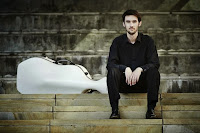 |
| Benyounes Quartet |
 |
| Philip Higham - photo Kaupo Kikkas |
The concert opened with Britten's Simple Symphony, a work which Britten wrote for string orchestra in 1933/34 basing it on themes from pieces which he had written as a teenager. It was written for amateur performance by a string orchestra, and inevitably performance by a professional string quartet changes the work's character. The quartet opened the Boisterous Bouree with nice crisp playing, but I did wonder whether their approach made it sound a little too arch. The Playful Pizzicato was highly effective and they made a lovely rich sound in the Sentimental Sarabande. But this is a piece which really does call out for sweep of massed strings. The Frolicsome Finale was suitably fast and furious.
Next, cellist Philip Higham played Britten's Cello Suite No. 3, one of the composer's final works; something which Higham linked to Schubert's late String Quartet in his engaging spoken introduction. The suite was written in 1971 and inspired by Rostropovich's playing of Bach's cello suites. It was written for Rostropovich as a present, the year Rostropovich and Britten visited Russia and Britten based it on a group of Tchaikovsky's arrangements of folk melodies plus the Russian Orthodox hymn for the dead, the Kontakion. To the nine movements, Britten adds a coda in which each tune of his source material is played straight, finishing with the Kontakion. For many observers the piece is very much about Britten coming to terms with his mortality.
Higham played with a finely grained tone, bringing a melancholy singing line to the Kontakion in the opening movement, Introduzione accompanied by left hand pizzicato which was less like the tolling of a bell and more an unnerving interruption, a disturbing of the musical elements. The Marcia had a nice swagger, leading to the Canto with its delicate fragments of melody and bursts of passion. Higham brought a lovely singing tone to the Barcarolla, combining delicacy and strength. The mysterious Dialogo was not as theatrical as some performances, but Higham made it rather haunting. The Fuga was notable for the intense way that Higham made the melody sing, followed by a quicksilver Recitativo: Fantastico. Higham displayed some brilliant fingerwork in the Moto perpetuo before a finely toned Passacaglia. Higham showed a fine sense of the structure, gradually building the movement up to a final vibrant climax before the simple beauty of the statements of the source material. Higham's performance was perhaps not quite as dark as some that I have heard, but he brought great poise to the piece and made it very moving.
After the interval all five players joined in a performance of Schubert's String Quintet, his final work for chamber ensemble written some two months before his death. Instead of using an additional viola, Schubert uses a second cello and exploits the richness of the cello's lower register.
The opening Allegro opened with a light transparent sound, fine grained and slim toned. The first subject was quite light and the playing wonderfully impulsive. For the second subject, the lovely melody was finely sung by the cellos. In the development we had moments of lively incisiveness and of great delicacy. In the recapitulation the group's performance of the first subject seemed even more impulsive with a build of up excitement towards the re-statement of the cello melody.
The second movement Adagio was given at a very steady tempo, with a lovely sustained tone giving the movement a timeless feel over long paragraphs; haunting beauty and superb control. The middle section was by contrast vibrantly strenuous. By the end of the movement though, I did wonder whether the musicians were rather too seduced by the beauty of the moment and that more forward momentum would have improved the overall structure of the work. The scherzo opened with fine attack and the group took the movement at quite a fast tempo, making it impulsive and vivid, full of accents and highly defined articulation. The trio was a strong change of mood, quietly intense with time standing still. The finale, Allegretto, was a crisp and heavily accented dance. The episodes of the rondo displayed some delicacy and transparency along with some strenuous virtuosity. The final reprise of the rondo theme was amazingly incisive, though the group essayed a rather unwise portamento at the end. There were moments when the open octaves that Schubert writes came under a little bit of stress, but technically this was generally a very strong and confident performance. The young players brought a vivacity, freshness and impulsiveness to Schubert's great final work.
Elsewhere on this blog:
- WIN a copy of Music: The Definitive History our latest Competition
- Beauty and Control - Songs of Home Njabulo Madlala and William Vann - CD review
- Scraping the Bottom - Christopher Gillett - Book review
- Julian Anderson - The Discovery of Heaven - CD review
- Intriguing new play - Sins of the Fathers by Jessica Duchen
- Spectacular cast - Albert Herring at the Barbican
- Opera or Oratorio - Philip Glass's Satyagraha at ENO
- Second view - Mozart's Magic Flute at the London Coliseum
- Britten - Sacred Choral Music - Choir of New College, Oxford - CD review
- Les Chevaliers de Saint Hubert in Jacques-Francois Gallay
- Britten - Canticles - Konstellation
- An encounter with the Hermes Experiment
- Britten at Temple Church
- Phoenix Rising - Stile Antico at Cadogan Hall
- Home




.webp)

.jpg)




No comments:
Post a Comment